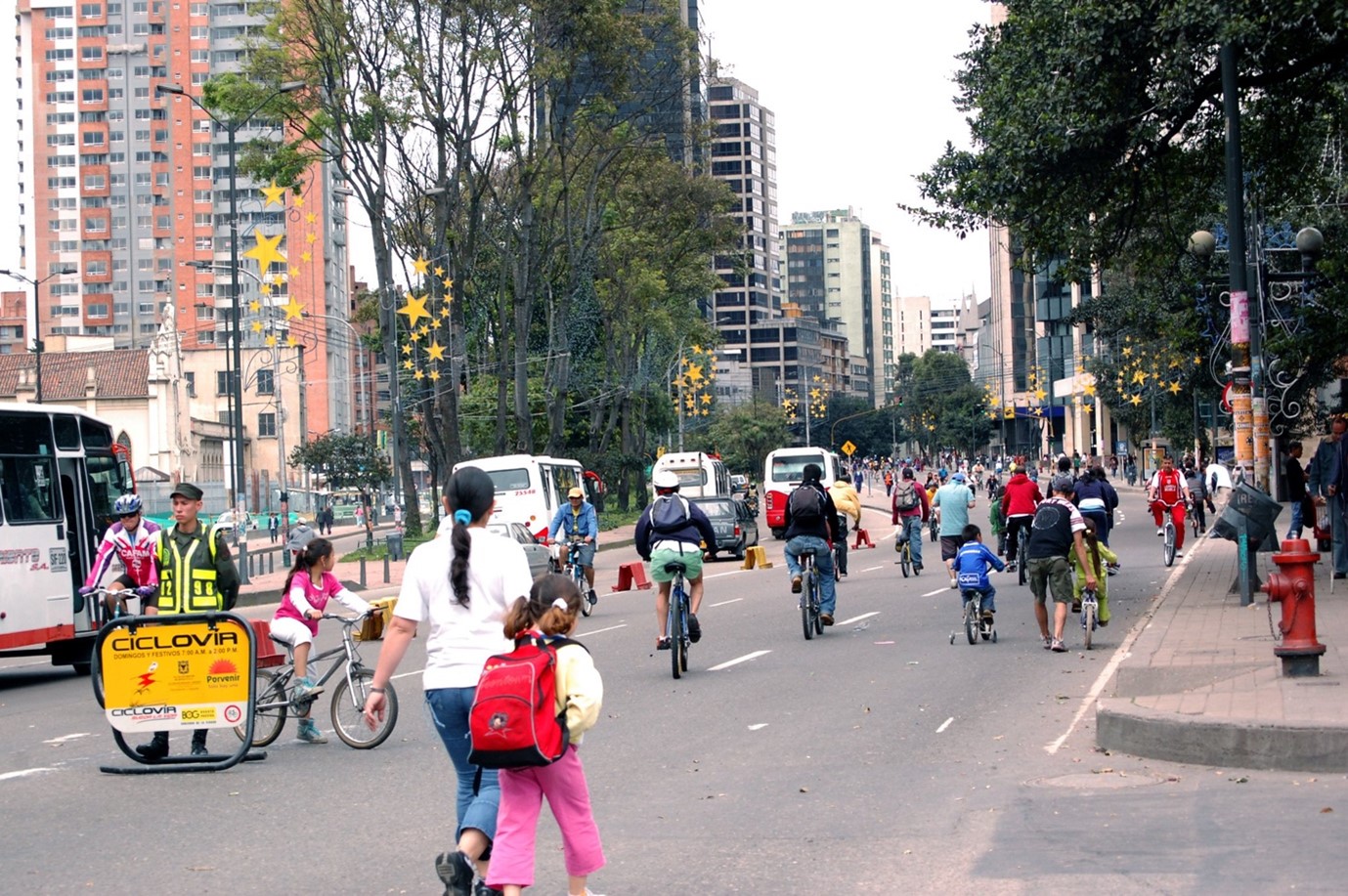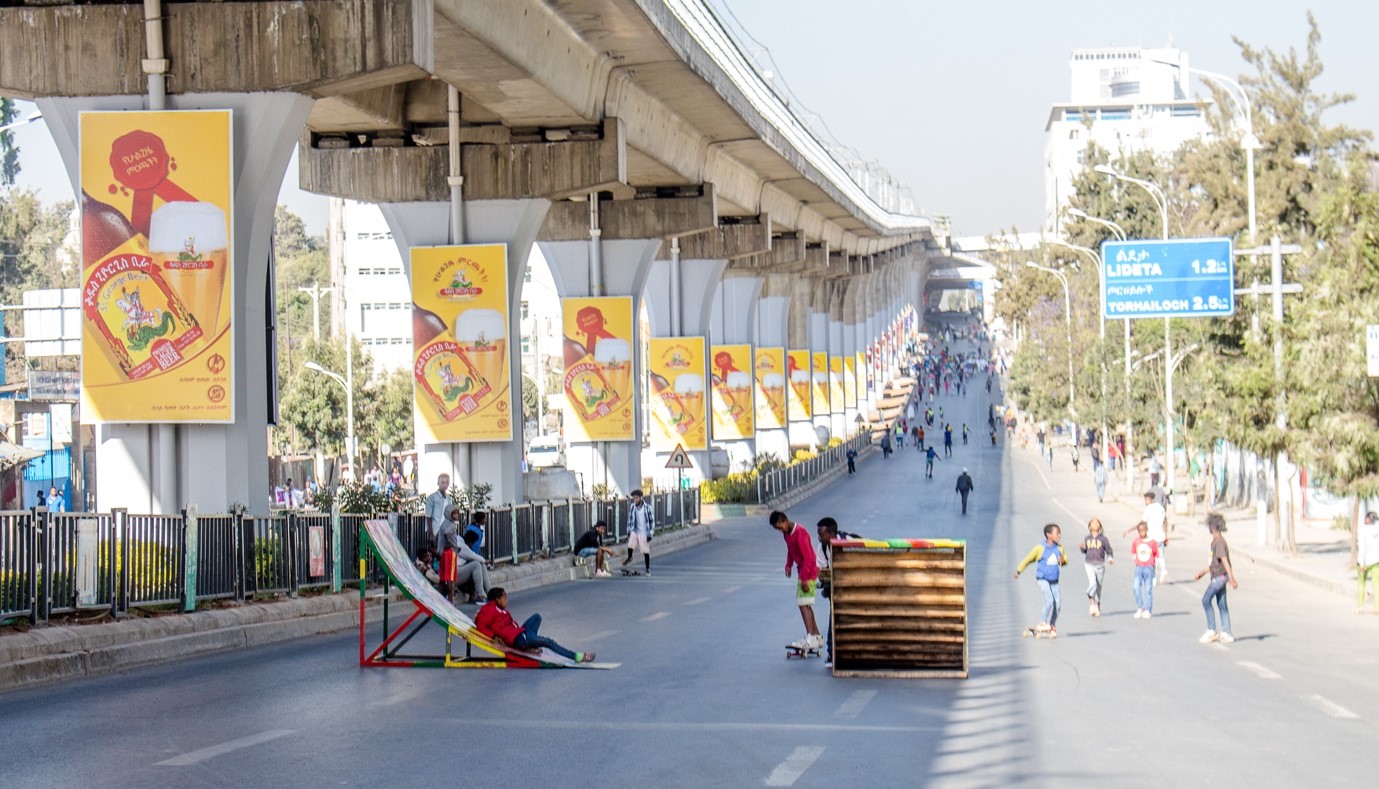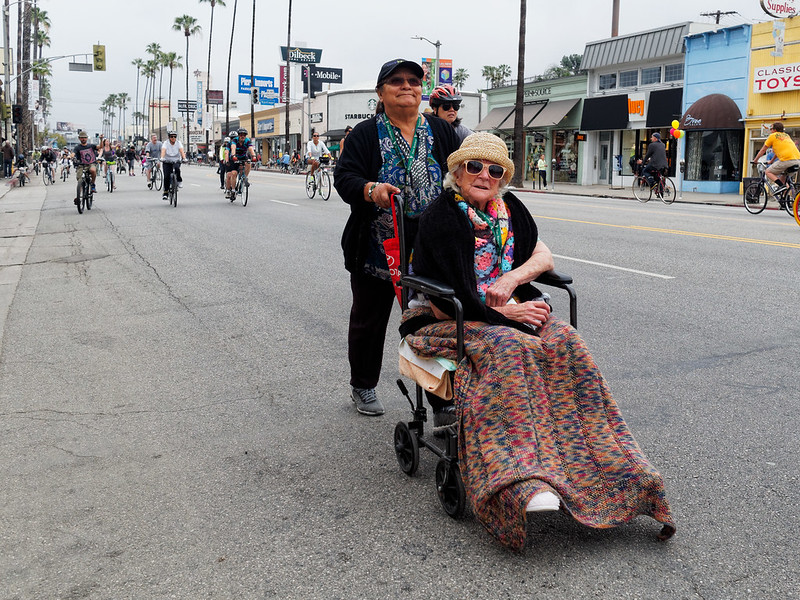
As cities become more congested, traffic fatalities continue to rise and the impacts of climate change escalate, the need for sustainable and safe transportation solutions has reached a critical juncture. The World Health Organization reports an alarming statistic: 186,300 children lose their lives annually due to road traffic crashes while nearly 2 billion more cars are projected to hit the roads in the next 30 years. In this urgent context of converging challenges, “car-free” days have emerged as a powerful and innovative concept.
Car-free or “open street” days are initiatives organized by cities and communities that block most car traffic from an area and welcome in pedestrians and cyclists for special activities and to enjoy the city in a new way. Car-free days have a powerful reframing effect for participants, helping to show how the vast amount of space dedicated to cars in cities might be used differently and how walking and cycling can feel on city streets when not surrounded by large vehicles. They are a wonderful way to promote alternative modes of transportation and, when implemented regularly and at scale, can even significantly mitigate the negative environmental impacts caused by cars.

However, car-free days face persistent misconceptions. These misconceptions often stem from a resistance to change, misinformation or a lack of understanding about the potential positive outcomes of embracing car-free days. As a result, the transformative potential of car-free days remains untapped in many communities, and we continue to grapple with the detrimental effects of excessive car use in many cities.
Myth 1: Car-Free Days Are Inconvenient and Disruptive
One of the prevailing misconceptions is that car-free days disrupt people’s daily routines and cause inconvenience.
Cities that embrace car-free days regularly show this is not the case. During Bogotá’s Ciclovía, major roads are closed to most cars on Sundays and public holidays, allowing cyclists, pedestrians and skaters to take over the streets. In contrast, Bogotá’s car-free day occurs on a weekday, restricting cars citywide from 5 a.m. to 9 p.m., with only public transport, bicycles and emergency vehicles allowed. For both initiatives, essential services like public transportation and emergency vehicles are still operational, ensuring that the city can function without significant disruption. By implementing these measures, Bogotá minimizes inconvenience to residents and strikes a balance between promoting alternative modes of transportation and maintaining necessary mobility.

Ciclovía began in 1974 to promote physical activity and reduce traffic congestion. Since then, it has grown into a cultural event spanning 120 kilometers (75 miles) of car-free space, with an estimated 1.4 million participants weekly. The initiative has influenced urban planning locally but also globally, inspiring similar projects in other cities. The positive response has led to plans for expansion within Bogotá, aiming to benefit even more communities.
Continuing success of Bogotá’s Ciclovía and car-free day highlights the value of car-free spaces in creating healthier, more sustainable urban environments without disrupting cities’ core functions.
Myth 2: Car-Free Initiatives Penalize Car Users and Limit Mobility
The misconception that car-free initiatives are “anti-car”, or force residents to abandon vehicles to access city centers, stems from a traditional mindset focused on car-centric urban development. In fact, car-free days aim to do the opposite: they are about enhancing, not limiting, accessibility and mobility within urban centers. These initiatives aim to improve accessibility by leveraging urban density to everyone’s advantage. Cities frequently face congestion due to the influx of people and vehicles, leading to hindered movement. By temporarily removing cars, streets become more efficient, allowing public transit, walking and cycling to shine as viable commuting options. This not only challenges the common belief that cars are the sole means of efficient travel, but also brings to life the idea of a well-balanced, sustainable urban transportation ecosystem.
In Kampala, a city dominated by motor vehicle traffic and an unregulated informal public transport system, active mobility is a new concept to many residents. Prior to the city’s first car-free day, in March 2023, media outlets incorrectly reported that multiple streets would be inaccessible to private cars. The city responded by clarifying the car-free route, which was just under one kilometer, and widely sharing the diversion plans on social media and at press conferences, including assurances that access to churches in the city center would remain a priority.
Car-free days should be about increasing access to the public, not limiting it. Clear public communication and engagement with the media and community groups is essential, not only to combat this myth but to inform future planning of car-free days to ensure consideration of local context and to build support for public transportation systems’ integration with active mobility infrastructure.
Drawing on her experience in Addis Ababa, Menged Le Sew co-founder Seble Samuel advises cities looking to start car-free days to collaborate with diverse organizations to reach different audiences and communicate inclusive messages in order to ensure intentions of open streets are understood.
Myth 3: One Day Without Cars Cannot Address Larger Transportation Challenges
Another misconception is that car-free days have a limited effect on the broader urban transportation system.
Car-free days may not single-handedly solve all transportation challenges, but they serve as a powerful catalyst for change. They provide residents a chance to experience the city without cars, try alternative modes of transportation and inspire behavior change, encouraging individuals to incorporate active mobility into their daily lives. Furthermore, car-free days spark conversations among communities, businesses and policymakers, often leading to more comprehensive strategies and policies for sustainable transportation.
Raahgiri Day in Gurugram, India, started as a pilot project in 2013 and has grown into a weekly event attracting thousands of participants. An overwhelming 87% of participants stated that they now choose cycling or walking for shorter distances outside of Raahgiri Day. And close to 28% of participants purchased a bicycle after the experience. In fact, Raahgiri Day has now become a national movement, expanding to over 70 cities across India, and has won global and national awards. The movement has contributed to a proliferation of active mobility initiatives in India, including India’s first automated bicycle sharing system launched in Bhopal in 2017, the state of Haryana’s adoption of the Vision Zero approach towards road safety and more.

Car-free days can also be an opportunity to test plans for non-motorized transport infrastructure cheaply and effectively. Car-free initiatives can be self-sustaining or very low-cost, helping city authorities create quality public spaces quickly and demonstrate the benefits of the approach. Kampala’s first car-free day, for example, selected a route earmarked for the extension of its first non-motorized transport corridor. This extension, planned for over four years, had slipped from public consciousness, but by incorporating cycling activities into the car-free day, it was brought back into focus.
Myth 4: Car-Free Days Negatively Impact Businesses
Skeptics argue that the restrictions on vehicle access and potential changes in traffic patterns during car-free days will discourage customers from visiting businesses, resulting in decreased sales and economic losses.
But foot traffic in commercial areas tends to increase so much during car-free days, that businesses instead have the opportunity to attract more customers. Studies have shown that car-free initiatives can provide a significant boost to the local economy. For instance, during the annual CicLAvia event in Los Angeles, an economic impact assessment conducted by the UCLA Luskin School of Public Affairs revealed that in 2013 the event generated more than $52,000 in increased sales revenue for the 128 businesses located along the route.

Moreover, regular car-free days create avenues for businesses to engage with the community and attract new customers over the longer term. In the Prospect Heights neighborhood of Brooklyn, New York, restaurants on Vanderbilt Avenue reported an average increase of 54% in customer visits after the first month of the city’s Open Streets Program. For one Raahgiri Sunday in Delhi, a striking 89% of the business establishments surveyed expressed support for road closures, 41% of establishments began opening their doors earlier on Raahgiri Sundays compared to regular Sundays and 71% reported a surge in sales.
These examples exemplify how car-free days can foster local economic growth by enhancing the vibrancy of urban areas.
Myth 5: The Influence of Car-Free Days on Climate Change and Pollution Is Insignificant
There is a widespread belief that car-free days barely scratch the surface of the monumental challenges posed by climate change and air pollution.
While car-free days alone will not resolve air quality or climate problems, a well-designed and consistent implementation of car-free days can significantly enhance urban air quality. An example of this positive impact can be seen in Kigali, Rwanda, where car-free days were introduced in 2016 as a monthly event and gradually expanded to occur every second Sunday. During these events, a 10-kilometer stretch of road is closed for three hours in the morning. Concurrently, between 2017 and 2020, Kigali witnessed a notable 15% reduction in particulate matter levels (PM2.5) during car-free days.
In Bogotá, studies on Ciclovía also underline its positive effects on health and air quality. Particulate matter (PM10) levels were found to be 13 times lower on Sundays during Ciclovía compared to regular weekdays, falling below the World Health Organization’s prescribed limit. And Raahgiri Sundays in Gurugram saw less than half the level of particulate matter (PM2.5) compared to average weekdays.

Cities planning to implement car-free initiatives in the future should be mindful that the success of improving urban air quality hinges on factors such as geographic scope and frequency. Regular car-free days are much more likely to have a significant impact than annual events. It is also crucial to avoid transferring pollution from one street to another through traffic diversions. Careful planning of public transportation alternatives can effectively mitigate this issue.
—
The multitude of benefits car-free days bring, from fostering vibrant public spaces and cohesive communities to driving economic growth and prioritizing sustainable transportation options, are undeniable. But addressing public concerns is crucial to their success so that more people are able to experience what makes them special.
Nikita Luke is a Senior Project Associate for Health and Road Safety at WRI Ross Center for Sustainable Cities.
Emmerentian Mbabazi is a Project Specialist for WRI Africa’s Cities program focused on sustainable transport solutions.





